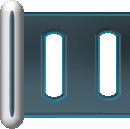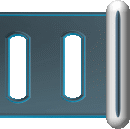|
The male : The penis is bent back or coiled in a muff defender (preflea(prechip)), except during the erection; he(it) is maintained in this position by a pair of muscles in the form of belt. To most of the mammals; the yard is established(constituted) by three columns of spongy tissues which swell by vasodilatation during the erection. The penis of the cetacean rather consists of fibrous and hard material. According to some, his(her,its) érectilité would result simply from the elasticity of this fibrous material, when muscles ré tractors loosen. The real mechanism is probably more complex, as well as it was proved at the bull whose yard contains numerous similar anatomical details to those of the erectile organ of the male cetaceans. Testicles, lengthened(stretched out), are not, as for the majority of mammals, locked into an external ( the scrotum): they are situated in the abdominal, just cavity behind loins. This arrangement meets itself at the elephant and at the daman (ongulé primitive alive mammal in Asia Minor and in Africa). The size of the male genital glands increases strongly in the puberty: the testicle of immature dolphin(dauphin) has the dimensions of a little finger and weighs about twenty grams. In the adulthood, he(it) is also big as the front arm (although considerably more thick) and his(its) weight reaches(affects) several kilograms. Produced in testicles, sperm cells throw(cast) themselves into the lengthened(stretched out) body formed by the pelotonnement of a unique(only) canal, the épididyme. They finish their maturation during their migration which brings them in the tail of the épididyme, where they are stored (this tail forms several masses to certain sorts). Sperm cells are sent to the urethra via the testicle cord. The sperm of mammals is a semi-fluid substance formed by the products of the various organs spread out since testicles up to the lacuna urinaire. To cetaceans, these auxiliary glands are reduced to the only prostate, relatively small in the immature organs. The Females:
The anatomy of the reproductive organs of cetaceans females is very similar to that of the numerous sorts of mammals. As testicles to males(mates), both ovaries are situated in cavities abdominal, behind loins. Shrunk in their superior portion, both fallopian tubes collect ovules produced by ovaries and, after fertilization, assure(insure) the transfer of eggs towards the womb. The lower extremity of this last one, the collar, opens in the vagina. The walls of this cavity which ends in the genital crack are furnished with folds jutting out in the direction of the vulva, the folds the role of which is unknown. These cul-de-sacs prevent maybe the water from penetrating into the device of reproduction, unless they reduce the losses of sperm after the copulation. The ovaries of odontocètes are lengthened(stretched out) and egg-shaped; their surface is relatively smooth Those mysticètes is of irregular shape and they are covered with girls protuberance round off. Ovaries contain dices the birth of cells (ovocytes) capable, after maturation, of producing an ovule and which(who) are surrounded with the other cells forming a follicle. Some get bigger and develop a space filled(performed) with fluids. These swelled follicles are responsible for a part(party) of the protuberances which furnish the ovaries of mysticètes. In the approach of the period of the couplings up, one of these follicles pursues his(her,its) growth, to break (ovulation) in little meadows in name(appoint) of the copulation. The freed(released) oocyte is transported at the end of the utérin tube. Cells remaining in this follicle multiply and form a structure of yellow one gray, the "yellow body"("corpus luteum"), which degenerates if the egg is not fertilized and which remains till the end of the gestation should the opposite occur. The yellow body(corpus luteum) degenerates door the name of " white body ". To cetaceans, contrary to the other mammals, the white bodies do not disappear: representing each an ovulation (but not inevitably a gestation), they thus allow to reconstitute the reproductive history of every animal. The biologist can so estimate(esteem) the number of gestations of one cetaceans, what establishes(constitutes) an essential datum for managements healthy of the stocks of these creatures. |




